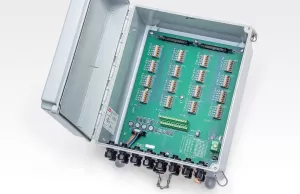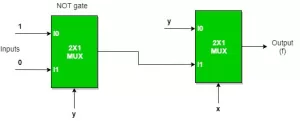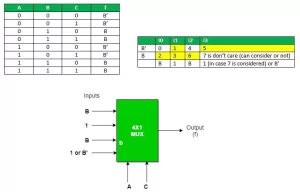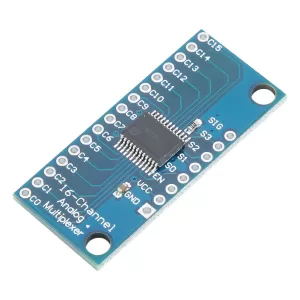
Multiplexer vs Demultiplexer: Key Differences and Applications
January 05 2024  1567
1567
Inquiry
Global electronic component supplier AMPHEO PTY LTD: Rich inventory for one-stop shopping. Inquire easily, and receive fast, customized solutions and quotes.
QUICK RFQ
ADD TO RFQ LIST
In this blog, we delve into key differences, working principles, and diverse applications of Multiplexer and Demultiplexer.
What is a Multiplexer and How Does it Work?



Basic Requirements of a Multiplexer
- Multiple Data Inputs: Usually denoted as D0, D1, and so forth.
- Select Lines: Control lines that decide which input is sent to the output, such as S0, S1, etc.
- Output Line: The one channel on which the selected data is sent.
Why Multiplexer is Used?
- Effective Bandwidth Utilization: Saves important bandwidth resources by combining many signals into one.
- Reduced Transmission Costs: Lower transmission costs result from fewer channels.
- Centralized Control: Centralized control makes it simple to choose from and switch between several data sources.
What is a Demultiplexer?

What Does a Demultiplexer Do?
- Accepts a single input signal.
- Uses a selection of lines to decode the input.
- Distributes the data that has been decoded among several output channels.
How Demultiplexer Works?
With the help of control signals, a demultiplexer can route a single input signal to one or more output lines. A demultiplexer consists of one input line, (n) selection lines, and (2^n) output lines in its simplistic version. The input signal's designated output line is determined by the selection lines. For instance, if there are two selection lines, the demultiplexer can have four output lines. The input signal's destination is dictated by the control signals. The input signal is directed to a specific output when a control signal is applied to the demultiplexer, activating that particular output line. In essence, the demultiplexer "de-multiplexes" the input signal, forwarding it to the specified output line by the control signals. In digital systems and communication networks, demultiplexers are frequently used to route data from a single source to multiple destinations, enabling effective data distribution and transmission.Video related to Multiplexers and DeMultiplexers
Difference Between Multiplexer and Demultiplexer
| Feature | Multiplexer | Demultiplexer |
| Number of Inputs | Multiple | Single |
| Number of Outputs | Single | Multiple |
| Function | Data Selector | Data Distributor |
| Typical Use Case | Combine signals for transmission | Replicate signals for distribution |
Why is Multiplexer Called a Data Selector?
Because it chooses one specific data stream from multiple options based on the control signal.Why is Demultiplexer Called a Data Distributor?
Because it replicates a single data stream and sends it to multiple destinations based on the control code.Where Multiplexer is Used?
- Analog-to-Digital Conversion: Several analog signals are chosen and converted into digital format for processing in electronic devices using multiplexers. This is frequently utilized in instrumentation and data-gathering systems.
- Data Routing: To enable effective data processing and control, multiplexers are employed in digital systems to route data from several sources to a single destination.
- Address Decoding: Multiplexers are used in digital systems to decode addresses in input/output and memory devices. This enables the system to choose particular memory regions or devices according to control signals.
- Display Systems: To choose which display segments to control and input data into, multiplexers are utilized in LED and LCD systems.
Where is Demultiplexer Used?
- Communication Systems: The same data can be transferred to several locations by using demultiplexers, which divide a single input signal among several output lines. Demultiplexers, for instance, are used in telecommunications to divide multiple data streams from a single transmission line.
- Data Distribution: In communication networks, demultiplexers are used to efficiently transmit and distribute data by routing incoming signals to the right location depending on control signals.
- Parallel-to-Serial Conversion: Demultiplexers can be used to transfer data from multiple streams in parallel over serial communication channels by converting them to a single stream in serial.
Conclusion
In conclusion, multiplexers and demultiplexers are essential parts of digital systems that perform different but complementary tasks. As the foundation of contemporary digital communication and control systems, engineers and fans alike must comprehend their distinctions and uses. These devices continue to be essential in the constantly changing field of digital electronics, whether they are used to distribute data to various destinations or optimize bandwidth use with multiplexers and demultiplexers.Populer Posts
CYPD4125-40LQXI
Infineon Technologies
MAXQ1050B-2012+
Analog Devices Inc./Maxim Integrated
MAX1786EUI+
Analog Devices Inc./Maxim Integrated
STSPIN32F0TR
STMicroelectronics
CP3BT26G18ABKX/NOPB
Texas Instruments
MM912H634CM1AER2
NXP USA Inc.
TMC2084-HT-E2
SMSC
UC3877DWP
Unitrode
CY7C63613C-SXC
Infineon Technologies
CY8C20636A-24LQXIT
Infineon Technologies
CY8CTST200-24LQXI
Infineon Technologies
CY8C20637-24LQXI
Infineon Technologies
